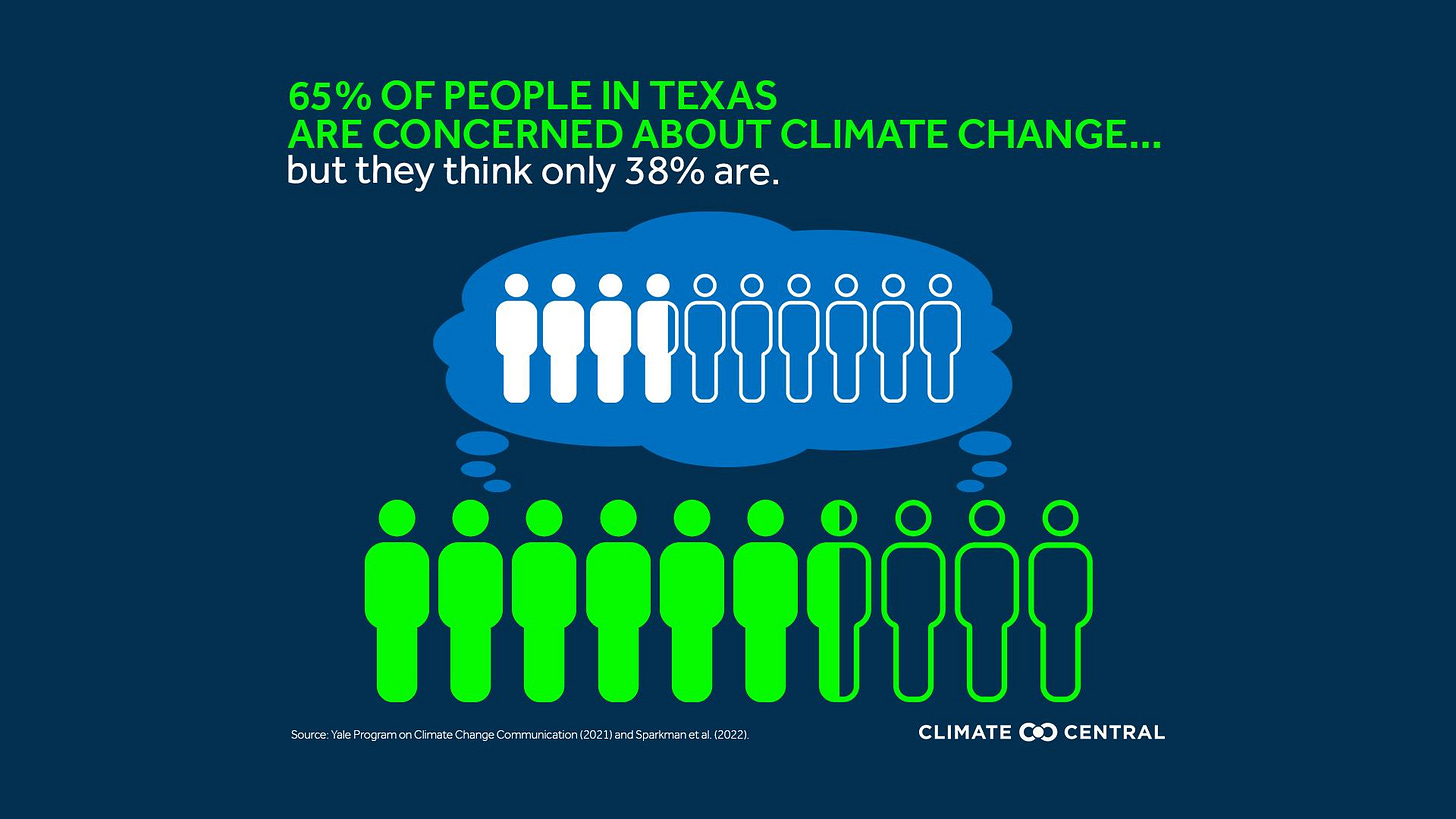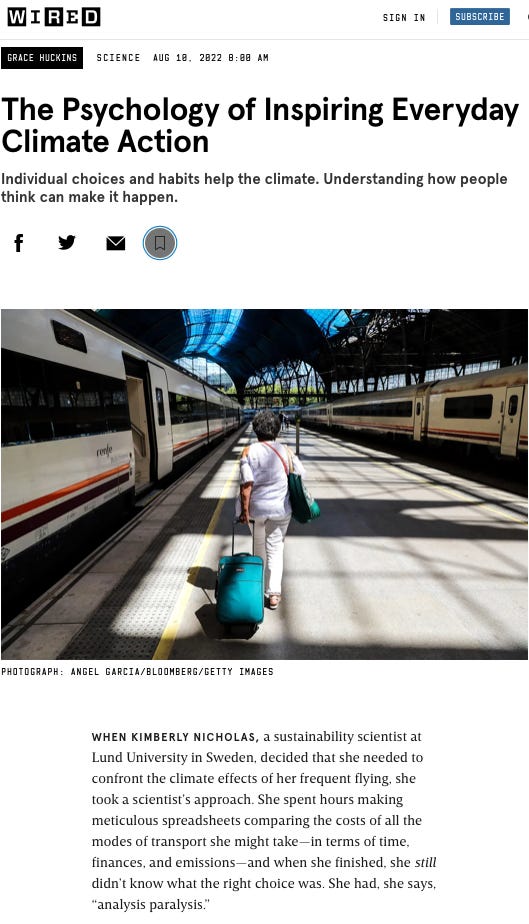How to fly less
Facts: Americans do care about climate; Feelings: Climate dissonance; Action: How to cut your own flying, and shift the system.
Hi friends, hope you are enjoying summer! We had a spontaneous picnic dinner in the courtyard with our neighbours this week.
Thanks so much to the hundreds of you who replied to my survey for the personalised climate action guide last month, it was so helpful and I really appreciate it! Updates on the beta version coming soon! :)
If you’re new, welcome! Here’s where you get your expert climate advice:
Now, on to this month’s edition…
Facts: Americans Do Care About Climate
A new study with the very Zeitgeisty title “Americans Experience A False Social Reality” shows that most Americans (65%) ARE concerned about climate change.
But they wrongly THINK others are not. On average, Americans think just 43% are concerned.
The 22% gap between perception and reality means people think the climate-concerned are a minority, when in fact we’re a majority.
The authors describe false social reality as “a near universal perception of public opinion that is the opposite of true public sentiment”. People feel like they live in a different world than the actual one. Underestimating climate concern was found across all 50 states.
The same pattern was true of support for climate policies like 100% renewable energy mandates & a Green New Deal; two-thirds of Americans support them, but they think only about one-third do.

This misperception that others don’t care about climate can reduce how much people talk about climate, which prevents climate organising. Over-estimating the size of the opposition decreases motivation and political pressure to pursue climate policy.
So, go forth knowing that others do care and are concerned about climate— and talk and act accordingly.
Feelings: Climate Dissonance
The evidence above notwithstanding, sometimes we run into climate cluelessness that can make living with our climate knowledge really tough.
I want to share some words a reader named K. wrote me:
“I’ve barely been able to follow the news because reading/ hearing about droughts, wildfires and dying rivers makes me seriously freak out about my new baby’s future.
And now my company just posted a message celebrating National Aviation Day! They claim that “nearly everyone” flies, but that’s not true— it’s the relatively wealthy that fly, thereby destroying things for those who cannot afford flying, and who are hit hardest by climate change.
They also say that air travel is expected to double by 2035. AFAIK, if air transportation has doubled by 2035 we are seriously f*cked.
How shall I deal with this?”
It reminded me of a piece by the Swedish journalist Jens Liljestrand, called “I’m Tired of Showing My Child A Dying World.” (It’s an incredibly powerful read, even through Google translate for non-Swedish speakers.)
Liljestrand described taking his family diving in Kenya and finding only a reef full of slime. In the car ride back to the hotel, his eleven-year-old daughter broke the silence:
“There were no colors. In all the movies it looks so pretty with all the colors. But now I know that’s just in the movies. It’s never like that in real life.”
Liljestrand declared he was done flying to “take selfies with a dying world in the background.”
For me, my flying wake-up moment came at a climate conference in 2012.
As I wrote about for Scientific American, and in Chapter 9 of Under the Sky We Make:
I knew flying made up most of my personal climate pollution. The hypocrisy that I, and most of my fellow attendees, had flown to this climate conference did not escape me. I was starting to feel like I was attending a conference of doctors puffing on cigarettes while telling our patients to quit smoking.
Over a cold beer after a long day at the conference, I decided to stop flying so much. I was talking to Charlie, a friend with wild hair and even wilder ideas. He was describing his adventurous 15-hour train trip from his home northeast of London. I confessed I’d taken a boring flight from Copenhagen in under 2 hours.
“How do you make your life work without flying?” I asked.
“I decided to stop flying within Europe. It’s doable,” he replied.
Something clicked. I could do that too.
Until that moment, I never imagined all the flying I could reduce, because I would get stuck on the one flight I couldn’t bear to imagine giving up: the one from Sweden to California to see my family, one of the journeys George Monbiot calls “love miles.” But now a middle ground appeared, something I could commit to. I couldn’t do everything right away, but I could start with something.
Many readers tell me that flying less is the hardest change to imagine making, and that seeing others continue frequent flying without thinking of the climate is one of their biggest sources of climate dissonance. So let’s have a look at how to start facing flying less.
Action: Fly less. Yes, you!
You already know, dear reader, that if you fly, it’s your biggest source of climate pollution.
Just 1% of the world’s population are regular flyers— and they represent 50% of climate pollution from flights. (I was in that group until I put my frequent flyer card in a museum.) Eeeeeek!
After a big drop in 2020, we see flying rebounding fast right now. But we know that a “recovery” of business-as-usual flying means climate catastrophe. Flying needs to decline, because flying today is at odds with the big-ass reductions in emissions we need to make to avoid blowing all of humanity’s remaining carbon budget in the next 83 months. (ACK!)
A great place to start is to join the Flight Free Campaign, which started here in Sweden. Some chapters, like the UK and US, offer the chance to pledge to go flight-free for a year, to make a significant personal change and work for broader system change. (If work or family commitments mean you can’t go flight-free, you can also pledge to be flight-free for holidays.) Also check out the Stay Grounded campaign.
Some ways to get started or ramp up staying grounded:
Personal flying
The majority of flying (about 80% in Sweden, and 70% in the US ) is for personal, not business, trips.
Most important: Don’t move really far away from people you love! (I personally failed to do this by moving to Sweden in 2010, while my family and many dear friends are in North America. After cutting my flying more than 90%, these “love miles” are the only flights I haven’t eliminated yet.)
Identify which flights you don’t need; cut those first. A recent study of frequent flyers found the travellers themselves rated only 58 percent of their trips “important” or “very important.”
If you can’t stop flying, choose a way to limit your flights: by frequency (e.g., max 1 per year), distance (e.g., no flights within your country or a certain distance), or purpose (e.g., to see loved ones).
For holidays, explore destinations close to home. (I’ve subscribed to the magazine of my local region, Magasinet Skåne, which is full of ideas of biking- or transit-distance hikes, cafes, and excursions. I’m also a member of the national association STF, who run cabins and affordable hostels in beautiful places around Sweden, many accessible with train).
TrainBikeTouring has some beautiful inspiration.
Here are 100 fabulous and climate-smart trips within Europe. (This is how I ended up taking Simon to an extremely fun and rather bizarre tropical resort beach vacation… near Berlin… one late winter.)
Work flying
Start conversations about flying at work, and find at least one person who wants to work towards your organisation flying less.
Get your organisation to use behavioural science to support flying less, following guidance from World Resources Institute to:
(1) Make virtual easy;
(2) Use positive social norms and pledges;
(3) Encourage senior staff to lead new norms by convening explicit travel-reduction conversations; and
(4) Formalize institutional policies and procedures, like changing budget templates or proposal guidelines.
Ready to dive in? FlyingLessResourcesGuide.info is a one-stop shop for everything from practical guides to hosting low-carbon conferences, to getting your organisation or industry to fly less, to how to push for funders and incentives to support flying less.
Join campaigns and communities like FlyingLess.org, which has fabulous resources and stories for academics flying less.
Here’s 4 minutes of me talking about how our department is going about flying less, and here’s a whole podcast on Flying Less!
Make institutional guidance like the Tyndall Centre decision tree to prioritise flights, and start conversations about equity. (Flying is usually distributed very unequally within organisations; their guidelines prioritise flights for younger and less advantaged scholars.)
Get inspired by others who are already leading the way- like these universities who have implemented or are planning measures like:

Collective action
Talk about flying less! Many people find this a touchy topic. Maja Rosén of “We Stay On the Ground” has written a warm, smart, empathetic guide to connecting over real conversations. Tips on where and how to have these conversations, and a super-helpful Q&A with arguments and strategies for responding to claims like “We need to keep flying to support tourism” or “Flying increases our understanding of the world.” Watch Maja in this 5-minute interview; she’s brilliant. (For the hardcore, here’s the full guide).
Support campaigns to make flying (and frequent flyers) pay their fair share, like A Free Ride. They advocate a frequent flyer levy, where everyone gets one tax-free return flight per year. Taxes increase for each subsequent flight after the first, and are used to support alternatives to flying.
If you’re a politician or airline industry exec who wants to keep flying alive:
Get cracking on the sweeping investments, regulatory changes, and tech breakthroughs you need to do now and over the coming decades to make flying Paris Agreement-compatible in the future. You can start with this ICCT report and the action checklist (Table 1) from a recent study.
Parting Tidbits
I got to talk about climate feminism, embodiment, and what the youth movement can teach the climate movement on the Plugged In Podcast:
I spoke to WIRED about how I overcame my analysis paralysis to start flying less— and what we know works to inspire everyday climate action:
Reading recommendation: Climate Change Coaching: The Power of Connection to Create Climate Action, by Charly Cox and Sarah Flynn, is an empowering and practical guide to strengthening relationships for climate and social care. Not just for coaches, but for anyone (teachers, parents, managers, …) who wants to help people identify their strengths and how they can be of service in the climate crisis.
xo,
Kim



Very timely. This is a hard one for me. I've just booked to go on a work trip that I know I'll find really worthwhile and that I couldn't do virtually. And because I live in New Zealand, it's flying or don't go. But with all the writing about climate change I've been doing, I can't go with a clean conscience.
The original plan involved one flight within New Zealand and the rest overseas, and I've realised that I could do the internal New Zealand flight on an overnight bus, even though it will take 12 hours. It's trivial compared to the rest of the flights I'll be taking, but it's the one flight where there's a practical alternative.
I love all these resources! I recently wrote about the benefits of American train travel (along with what needs improved) and have really touted public transit options since moving to the East Coast — where, admittedly, it is much easier to get on a train. I hope the rest of the U.S. soon sees more investments in rail and less investments in runways.